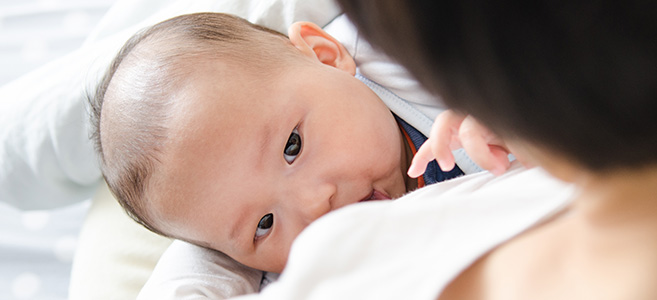
Welcoming a new baby is one of life’s greatest joys – but it can also be nerve-wracking, especially if it’s your first time. While it’s true that babies don’t come with instruction manuals, this list from Dr. Tiffany Kimbrough, pediatrician and medical director of our Mother-Infant unit, answers some of the most common questions we hear during those whirlwind first weeks.
Babies should feed 8-12 times in a 24-hour period. You may find it helpful to keep track of how often your baby is feeding with a feeding log, either on paper or using an app.
Babies need no other food than breast milk for the first six months. Mothers initially make a yellow substance called colostrum which is low in volume, but high in calories and nutrition. A baby’s stomach is only the size of a marble to start, so colostrum is all they need to feel full. Putting the baby to the breast often will help mom’s milk transition from colostrum to mature milk.
If mom isn’t able to produce ample breast milk or has trouble feeding, lactation resources and support are available. If formula is necessary, it’s recommended that liquid/pre-mixed formula be used for the first eight weeks before transitioning to mixing powdered formula. If introducing a bottle, avoid propping it on a pillow or blanket. This can cause ear infections and lead to choking.
There are a number of signs to look out for in a newborn that could signal an underlying infection or illness. Call the pediatrician if you notice:
Make sure you talk to your doctor before giving any medications.
Initially, babies should be urinating at least once every eight hours. This will increase once feeding is established.
A high or low temperature can be a sign of serious infection. You don’t need to check your baby’s temperature unless they’re acting sick. Call the doctor if you measure a rectal temperature of greater than 100.4°F or less than 97.2°F.
Babies can’t breathe through their mouths like adults can, so they rely on breathing through their noses. During times of congestion, apply 2-3 drops of nasal saline into the nose. This will likely cause your baby to sneeze and clear the nasal passages. If not, then suction the nostrils with a bulb suction syringe.
The umbilical cord will usually fall off on its own in about 7-14 days. When this happens, you may notice a small amount of oozing blood, which is normal. If the base of the cord becomes red or swollen, call the doctor as this is a sign of infection.
Babies should be bathed every couple days with warm water and a wash cloth. They shouldn’t be submerged in water until the umbilical cord has fallen off.
Dry skin is common in newborns. It will shed and be replaced within a couple weeks. Avoid lotions that contain perfume as they can cause a rash.
All car seats should be rear-facing in the back seat – ideally in the middle of the vehicle – for as long as possible. There are local agencies that will check your car seat for proper installation and fit. Find a car seat inspection location close to you.
Babies should be placed on their backs to sleep to decrease the risk of sudden infant death syndrome. They should be in their own crib or bassinet for sleeping, but ideally in the same room as an adult for the first 6-12 months. Do not use pillows, blankets and crib bumpers. For warmth, place your baby in a warm sleeper or swaddle sack and hat.
While baby is awake, place them on their tummy for brief periods of time to increase strength. This should always be supervised and is a great opportunity for talking and interacting with them.
Set the water heater to a maximum temperature of 120°F to avoid burns.
It’s really important to keep babies away from smoke. Family members and guests should go outside to smoke and then wash their hands and change their clothes before handling the baby.
 Babies can cry A LOT, especially in the first few months. It tends to peak around 4 weeks of age and then slowly gets better around 3 months. When your baby is crying, check to see if they’re hungry, cold or needing a fresh diaper. If not, there are ways to soothe your baby, such as swaddling in a blanket, making shushing sounds and gently swaying back and forth.
Babies can cry A LOT, especially in the first few months. It tends to peak around 4 weeks of age and then slowly gets better around 3 months. When your baby is crying, check to see if they’re hungry, cold or needing a fresh diaper. If not, there are ways to soothe your baby, such as swaddling in a blanket, making shushing sounds and gently swaying back and forth.
Some babies will still cry, which can be very stressful. It’s perfectly okay to leave your baby in a safe location for a short period of time (around five minutes) while you take a time out and calm yourself. If you can hear your baby crying, you know their heart and lungs are working and everything is okay.